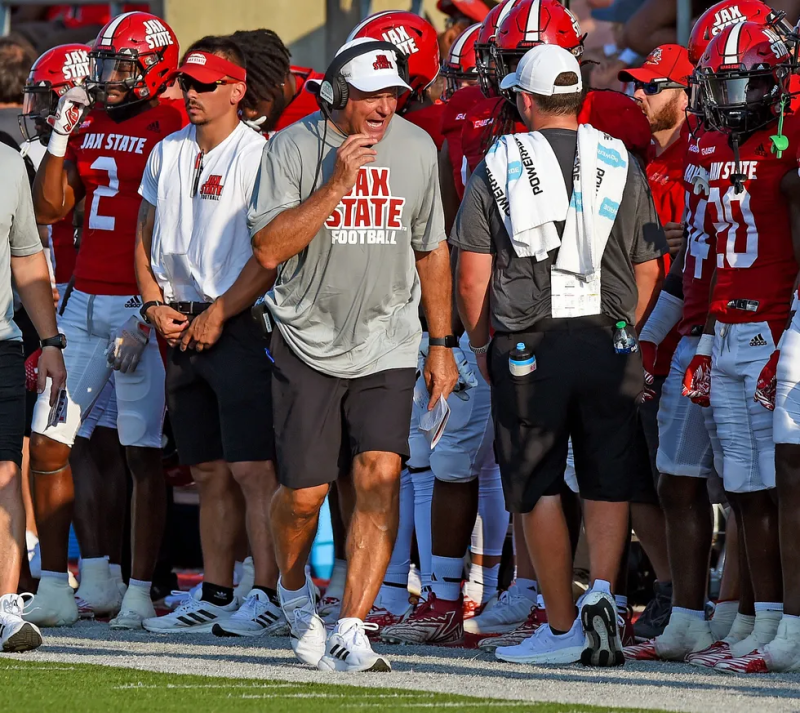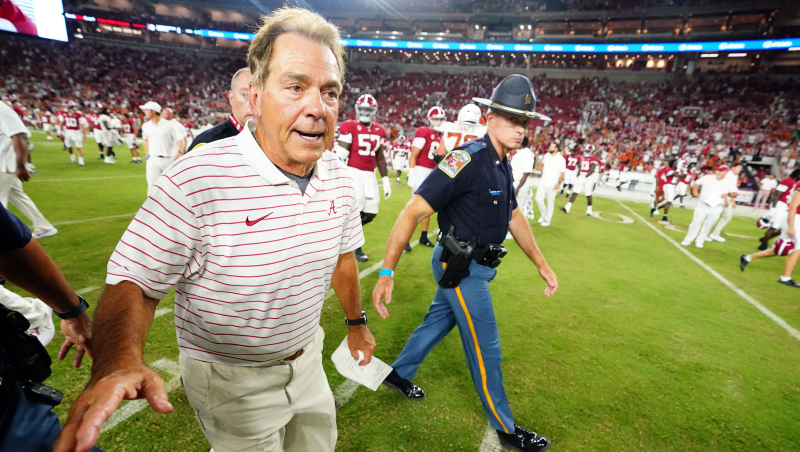As realignment scrambles college sports, some football coaches are due raises. Big ones.
When Greg Seitz’s phone rang on Oct. 27, 2021, the Jacksonville State athletic director had no idea his world was about to turn upside down.
As those who study college football realignment can attest, it’s a whirlwind process. Decision-making happens at a rapid clip.
Realignment has scrambled the sports world as we know it, but schools jumping from one Power Five conference to another is hardly the only move that leaves a ripple effect in its wake. If given the opportunity, no matter how last-minute it might be, most schools will choose to upgrade from the Football Championship Subdivision (FCS) to the Football Bowl Subdivision (FBS). There, the bowl payouts are bigger, the media-rights deals richer and coaches’ contracts even more eye-popping.
This season, Jacksonville State, which has since rebranded to Jax State, and Sam Houston State have done just that. They follow other schools like James Madison, Liberty and Coastal Carolina that have made the jump recently; Kennesaw State makes its FBS move next year.
For Jax State and Sam Houston, the domino effect started when Texas and Oklahoma announced in July 2021 they were SEC-bound. The Big 12 responded by raiding the American Athletic Conference. Next, the AAC filled spots by inviting teams from Conference USA. Then C-USA started making calls.
“First it was, would you have interest in having a conversation about maybe joining Conference USA,” Seitz recalled. “By Nov. 2, the following Tuesday, they’re on a campus visit. They made us an offer before they left, we worked through it Wednesday and Thursday and signed it early Friday morning. At 9 a.m. Friday I met with our staff — who had no idea this was happening — to tell them we were moving to FBS, and an hour later we were having a press conference about it.”
The most crucial task as colleges climb the conference realignment ladder: finding more money. And as schools make the jump from FCS to FBS, upgrade from Group of Five to Power Five, or switch from one Power Five conference to another, some football coaches are due for raises. Big ones.
More:SEARCHABLE DATABASE: College football head coach salaries
More:Who are college football's most overpaid coaches? Hint: SEC leads the way.
More:Deion Sanders, underpaid? He leads the way amid best coaching deals in college football.
Take Rich Rodriguez, for example.
The current Jax State coach, now in his second season, has plenty of experience playing among the big(gest) boys of college football. After an impressive run at West Virginia from 2001-07, Rodriguez and his zone-read offense landed at Michigan, one of the most coveted jobs in college football. He finished with a 15-22 record over three seasons. Then it was on to Arizona, where he went 43-35 from 2012-2017.
At Arizona, Rodriguez averaged just over $3 million a year in total compensation, then one of the bigger paychecks in college football — and now considered chump change in the Power Five. Hired at Jax State after the Gamecocks had accepted Conference USA’s invite but before the move became official, he signed a $500,000 contract for the 2022 season.
But now, as the Gamecocks establish themselves in FBS, Seitz understands Rodriguez will need a salary on par with his Group of Five counterparts. Hence the $500,000 raise he’s getting, bringing his total compensation for the 2023 season to $1 million.
“We understand we have to be competitive from a salary standpoint, and it’s not just with our head coach and assistants,” Seitz said. “We have to add more positions. The reason we’re at FBS is because of football, so we have to support that sport.”

Jax State is hardly the only school following this plan. With Houston’s jump from the American Athletic Conference to the Big 12 this year, football coach Dana Holgorsen was scheduled for a $1 million incentive bonus; Holgorsen didn't pocket the money, instead donating $1 million to UH's athletic department. Additionally, the football staff salary budget increased by $1 million after also increasing by $1 million for the 2022 season.
Some head coaching contracts even include a clause that says if the school switches conferences, especially if going from Group of Five to Power Five, the contract will be renegotiated.
A 'challenge' to justify coaches' big salaries
Of course, the decision to move to a higher level of competition — which means increased salaries across the athletic department, significant investment in facilities and a likely spike in student applications — is not all about the Benjamins. Money is just the majority of the determination.
And can cause headaches.
JMU athletic director Jeff Bourne, who’s been at the school 25 years, said the current, chaotic version of college football realignment “is an example of merging an institutional model with a for-profit model, where you have organizations making a real profit on paper, which means they have the ability to give back and pay these coaches the enormous sums they receive ...
“It does become a challenge on campus to justify (coaches’ salaries) sometimes, especially comparatively, like when you look at them in regard to what the president and vice president are making. But we’ve crossed over that horizon. Like anything else in college athletics, it’s difficult to back up.”
In 2021, the last year JMU was in FCS, Curt Cignetti made $510,000. This season, he's slated to make just over $675,000. Meanwhile at Sam Houston State, K.C. Keeler's base annual pay was $509,000 last season; this year it's $600,000, an 18% year-over-year increase.
It’s not just smaller schools moving up that can cause salaries, and therefore eyebrows, to raise either.
Pay is generally a reflection of where you stand in your conference. At Oklahoma and Texas, Brent Venables and Steve Sarkisian are set to make $7.1 million and $5.6 million, respectively, this season, some of the highest among Big 12 public schools. But in the SEC, where Saban will make $11.1 million from Alabama, Georgia’s Kirby Smart will make $10.5 million and five other coaches will make at least $9 million annually, those are decidedly middle-of-the-pack salaries.
More:Deion Sanders is Colorado's $280 million man
Conference USA TV deal puts small schools on map
JMU and Jax State had a significant advantage before they made the jump: they were powerhouse FCS programs. So far, their winning tradition has translated at the next level, too.
JMU went 8-3 last season, making its first-ever appearance in the Associated Press Top 25 and becoming the first team since 1978 — when Division I split into I-A and I-AA — to be ranked its first season transitioning to the higher subdivision. The Dukes obliterated No. 23 Coastal Carolina 47-7 in their final game of the season, winning the Sun Belt Conference’s East division. Their run has continued this season, as JMU is 5-0.
“We did a great job at being prepared, and we’re blessed to have a phenomenal staff,” Bourne said. “But in the world of athletics, it always helps to be a little lucky, too.”
Meanwhile Jax State — whose previous claim to fame was stunning Florida State 20-17 during the 2021 season in Tallahassee, where the Gamecocks also collected a $400,000 check — is 4-1 in its first full FBS year.
Each school has a plan for continued success, too.
In Virginia, state law requires any institutions transitioning to a higher level to develop a financial plan that projects future costs and revenues, and get approval from the state legislature to demonstrate “that this is a sustainable model long-term,” Bourne said. Virginia law also says that schools in an FCS conference can have up to 70% of their athletics revenue come from school funds and student fees, while those in an FBS conference outside the Power Five can have only 55% of such revenue from those sources. That puts a particular emphasis on the importance of fundraising and ticket sales.
“These are guardrails so when you do move, you’re in a position to sustain it and succeed,” Bourne said.
At Jax State, Seitz polled athletic directors at 10 schools who previously made the move from FCS to FBS, asking what they would have done differently. The answer was resounding: increase the scholarship count over two years.
Seitz implemented that immediately, moving Jax State’s scholarship count to 75 last year — FCS schools are only allowed 63, which made the Gamecocks ineligible for the 2022 FCS postseason — and the full FBS-allowed 85 in February. He’s convinced that gradual inflation is part of why the Gamecocks have already won four games. And he can’t wait to see what happens next.
“What I want people to understand is that this wasn’t just an athletic decision. This is going to raise the brand of our entire university,” Seitz said. “We’re playing in four midweek, nationally televised games on ESPNU when no other college football is on TV. Every sports bar in America is going to have Jax State on. Our brand is going to be everywhere.
"Do you know how incredible that is?”
Contributing: Steve Berkowitz
Follow Lindsay Schnell on social media @Lindsay_Schnell

Disclaimer: The copyright of this article belongs to the original author. Reposting this article is solely for the purpose of information dissemination and does not constitute any investment advice. If there is any infringement, please contact us immediately. We will make corrections or deletions as necessary. Thank you.







